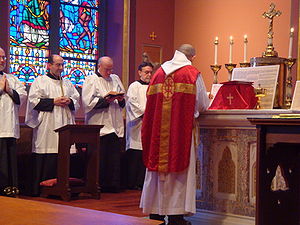라틴어 전례 사용
Liturgical use of Latin라틴어의 전례적인 사용은 기독교의 예배를 교회 라틴어로 수행하는 관습이다.이 관습은 라틴 교회의 전례 의식에서 전형적으로 발견된다.
역사
2-16세기
서양 기독교에서 예배용 라틴어의 사용은 2세기 후반 경 북아프리카에서 교황 빅토르 1세 시대에 시작되었는데, 교황은 코이네 그리스어의 기존 예배용어와 함께 라틴어를 도입했다.그 후 몇 세기 동안, 로마 전례에서는 라틴어가 점점 더 그리스어를 대체하게 되었습니다. 왜냐하면 라틴어는 신도들이 이해하는 자국어였기 때문입니다.7세기에, 아마도 동부에서 온 이민자들 때문에 그리스 전례로 단명하는 것이 있었지만, 라틴어는 곧 로마 전례 언어로 다시 확립되었다.시간이 흐르면서 자국어가 라틴어에서 멀어지면서 라틴어의 사용은 신성한 [1]언어로서의 역할로 이해되게 되었다.
16~20세기
가톨릭 학자들은 자국어로의 전환을 사전에 [2]논의했지만, 16세기 개신교 종교개혁은 자국어 전례의 원인을 옹호하고 이를 반카톨릭 [3]정서와 연결시켰다.이에 대해 가톨릭 교회 트렌트 평의회는 원칙적으로 자국어 예배를 비난하지는 않았지만 무분별한 사용을 금하고 라틴어의 [3][4]예배 적합성을 옹호했다.평의회의 결론 이후, 교황 비오 5세는 라틴어만의 의식을 이어가는 로마 의식의 개정된 전례서들의 사용을 성문화하고 널리 명령했다.
라틴어는 종교 개혁 이후 일부 개신교 예배에서 계속 사용되었는데, 종교 개혁은 일반적으로 자국어 예배의 사용을 중시했다.영국 교회의 1549년 공동기도서는 대부분 학술적인 목적으로 라틴어로 번역되었지만 게일어와 라틴어만 아는 아일랜드 성직자들 사이에서 그 번역의 일부 전례적인 사용이 있었다.성공회 전례문을 라틴어로 번역하는 관행은 1662년 [5][6]기도서와 1979년 [7]미국 성공회 공동기도서에서도 이어졌다.
현지 예배에 대한 요구는 17세기 비난받은 얀센주의 운동의 특징이었다.비록 라틴어에서 유래한 로망스어에 대한 자국어 예배에 대한 의문은 여전히 논쟁의 여지가 있었지만, 교황 바오로 5세와 그 이후의 교황들은 중국, 조지아,[3][8] 그리고 오늘날의 몬트리올을 포함한 선교 지역에서 자국어를 제한적으로 사용할 수 있도록 허락했다.달마티아와 이스트리아의 일부 지역에서는 라틴어 대신 교회 슬라브어로 예배식이 거행되었고, 1886년에서 [9][10]1935년 사이에 슬라브어 사용 허가가 일부 슬라브어 지역으로 확대되었다.
20세기-현재
교황 요한 10세3세는 예배와 교회 전체를 위한 라틴어의 가치에 대한 강력한 지지자였다.1962년, 그는 "베티움 사피엔티아"라는 제목의 백과사전을 발표했는데, 이 백과사전에서 그는 라틴어의 공정성, 보편성, 불변성, 조형적 가치, 역사성,[11] 그리고 위엄을 높이 평가했습니다.그 해 말, 그는 요한 10세의 뒤를 이어 제2차 바티칸 공의회를 열었다.3세의 죽음은 그의 후계자인 교황 바오로 6세에 의해 계속되었다.평의회는 라틴어의 우수성을 확인하면서도 1963년 성례에 관한 헌법(Sacrosanctum Concilium)에서 자국어의 제한적 사용을 승인했다.1964년, 성스러운 의례 집회는 헌법을 시행하면서 미사의 [12]많은 부분을 현지어로 번역한 전례서를 준비할 수 있는 주교 회의를 승인했다.
1970년부터, 로마 의식의 전례서들은 완전히 개정되었다.이 개정안은 모든 의식을 권위 있는 라틴어 원문의 승인된 번역에 따라 전적으로 현지 언어로 기념할 수 있는 허가를 포함했다.이 문서들은 바오로 6세의 미사를 라틴어로 [13]기념할 수 있게 해준다.
1988년 교황 요한 바오로 2세는 사도 서신 에클레시아 데이에서 주교들이 이전에 알려진 라틴 트리덴트 미사를 요청했던 단체들을 위해 기념할 수 있도록 허용했다.2007년, 교황 베네딕토 16세는 1970년대 이전의 개혁 라틴어 전례서 사용을 폭넓게 허가한 사도 서한 Sumorum Pontificum을 발표했다.2021년 프란치스코 교황은 사도 서신 Tradistis custodes를 통해 이러한 허용 범위를 제한했다.
가톨릭 교회의 현재 사용법
표준 에디션
라틴 교회 로마 의례에서 라틴어는 전례서의 전형적인 판본이 공포되는 언어이다.일반적인 판은 모든 자국어 번역이 [14]기반이 되어야 하는 판입니다.
언어 옵션으로서의 라틴어
미사의 주요 언어가 모국어일 때도, 글로리아, 크레도, 생투스, 파터 노스터, 그리고 아그너스 [15]데이와 같은 미사의 불변의 특정 부분을 라틴어로 낭송하거나 노래한다.
2004년, 신성 예배 성당은 사제들이 예정된 현지 [16]미사 이외의 라틴어로 미사를 지내는 것이 항상 허용된다고 단언했다.
전통주의 사용법
전통주의자라고 주장하는 가톨릭 단체들은 주로 [17]라틴어로 의식을 규정하는 오래된 전례 서적을 계속 사용하고 있다.
레퍼런스
- ^ Pecklers, Keith (2005) [2003]. Worship: A Primer in Christian Ritual. Collegeville, MN: Liturgical Press. p. 41–42.
- ^ OMalley, John W. (January 29, 2007). "Trent and Vernacular Liturgy". America. Retrieved April 27, 2022.
Even before the Reformation, scholars discussed the advisability of vernacular liturgies, or at least more use of the vernacular. Even Erasmus, a great Latinist, argued that it be more extensively employed. The actions of the Reformers, therefore, did not come out of nowhere.
- ^ a b c Priest, Jeremy J. (January 13, 2019). "Forbidden Translations? A Brief History of How the Mass Came to Be Rendered in the Vernacular". Adoremus. Retrieved April 27, 2022.
- ^ Denzinger, Heinrich (2012). Hünermann, Peter (ed.). Enchiridion symbolorum (43rd ed.). San Francisco: Ignatius Press. §1749.
Although the Mass contains much instruction for the faithful, the Fathers did not think that it should be celebrated in the vernacular indiscriminately.
- ^ Wohlers, Charles. "Liber Precum Publicarum: The Book of Common Prayer in Latin (1662)". Society of Archbishop Justus. Archived from the original on 12 February 2022. Retrieved 8 April 2022.
- ^ Muss-Arnolt, William (1914). "Chapter V.: Latin and Greek Translations". A History of Translations of the Prayer Book of the Church of England and of the Protestant Episcopal Church of America. London: Society for Promoting Christian Knowledge. Archived from the original on 8 April 2022 – via Society of Archbishop Justus.
- ^ "Liber Precum Publicarum". Society of Archbishop Justus. Retrieved 29 April 2022.
- ^ Hsia, Ronnie Po-Chia (1998). The World of Catholic Renewal, 1540-1770. New York: Cambridge University Press. pp. 210–211. ISBN 0521445965.
- ^ Krmpotic, M.D. (1908). "Dalmatia". Catholic encyclopedia. Retrieved 19 June 2014.
The right to use the Glagolitic [sic] language at Mass with the Roman Rite has prevailed for many centuries in all the south-western Balkan countries, and has been sanctioned by long practice and by many popes.
- ^ Japundžić, Marko (1997). "The Croatian Glagolitic Heritage". Croatian Academy of America. Retrieved June 19, 2014.
In 1886 it arrived to the Principality of Montenegro, followed by the Kingdom of Serbia in 1914, and the Republic of Czechoslovakia in 1920, but only for feast days of the main patron saints. The 1935 concordat with the Kingdom of Yugoslavia anticipated the introduction of the Slavic liturgy for all Croatian regions and throughout the entire state.
- ^ Pope John XXIII (February 22, 1962). "Veterum Sapientia".
- ^ Sacred Congregation of Rites (September 26, 1964). "Inter Oecumenici" [Instruction on Implementing the Constitution on Sacred Liturgy]. EWTN.
- ^ Philippa Martyr (11 July 2021). "Dr Philippa Martyr: The Novus Ordo was meant to be a Latin Mass". Catholic Weekly. Retrieved 29 April 2022.
- ^ "A brief history of the development of the Roman Missal". The Catholic Review. January 19, 2012.
Liturgical books are issued by the Holy See (the Vatican) as 'typical editions,' the authoritative Latin texts which are used for the celebration of the Liturgy in Latin, or as the basis for translation into local (vernacular) languages, which must then be approved by the Holy See.
- ^ Hardon, John (2013). "Latin". Catholic Dictionary (2nd ed.). p. 258.
- ^ 를 클릭합니다"Redemptionis sacramentum". March 25, 2004. §112.
Except in the case of celebrations of the Mass that are scheduled by the ecclesiastical authorities to take place in the language of the people, Priests are always and everywhere permitted to celebrate Mass in Latin
. - ^ Rocca, Francis X. (September 9, 2021). "The Power of the Latin Mass". Wall Street Journal.
외부 링크
 위키 인용문에서의 라틴어 의례 사용에 관한 인용문
위키 인용문에서의 라틴어 의례 사용에 관한 인용문



